偏波保持ファイバ
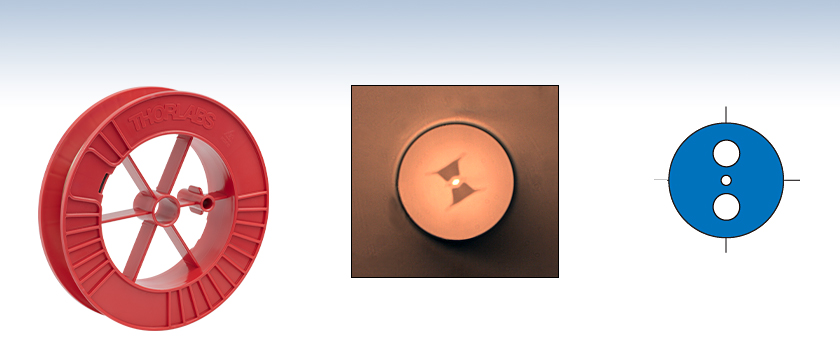
- 350 nm to 2200 nm Operating Wavelengths
- Fibers with Ø80 µm or Ø125 µm Cladding
- Bow-Tie or PANDA Stress Rod Configurations
Bow-Tie PM Fiber
PANDA PM Fiber
Fast Axis
Slow Axis
PM-405
400 - 488 nm,
PM Fiber with Pure Silica Core

Please Wait
| Stock Patch Cables Available with these Fibers | ||
|---|---|---|
| Type | Fibers Available | |
| Standard | FC/PC | PM-S405-XP, PM460-HP, PM630-HP, PM780-HP, PM980-XP, PM1300-XP, PM1550-XP, PM2000 |
| FC/APC | ||
| Hybrid | ||
| AR-Coated | PM630-HP, PM780-HP, PM980-XP, PM1550-XP | |
| Reflective-Coated | PM980-XP | |
| Available PM Fiber Types | |
|---|---|
| PANDA | Pure Silica Core |
| Standard | |
| Photosensitive | |
| Dispersion Compensating | |
| Bow-Tie | Standard |
| Bend- and Temperature-Insensitive | |
特長
- 入力時の偏光状態を保持
- PANDA型またはボウタイ型のファイバ断面
- 特殊な感光性ファイバ、分散補償、屈曲および温度変化の影響を受けにくいファイバもご提供可能
当社ではPANDA型とボウタイ型のシングルモード偏波保持(PM)ファイバをご提供しています。 この2つのタイプは使用しているストレスロッドに基づいて命名されています。 ストレスロッドはファイバーコアに平行に存在し、応力を付与することでファイバーコア内に複屈折を生じさせ偏波保持動作を可能にしています。 上の写真のように、PANDA型ではストレスロッドが円筒形であるのに対し、ボウタイ型では台形プリズムです。 通常の用途においてはいずれの型でも使用可能です。 製造工程において、非常に長い形状が求められる時、均一性を保つには円筒形のストレスロッドの方が作りやすいという理由で、歴史的には光通信の分野ではPANDAファイバが一般的でした。
当社では、特殊な偏波保持ファイバもご提供しています。 感光性ファイバは、UV光を照射することでファイバーブラッググレーティングを生じ、屈曲および温度変化の影響を受けにくい偏波保持ファイバは光ファイバージャイロスコープ(FOG)の用途に適しています。
偏波保持ファイバ(PANDA型)、純粋石英コア、350~680 nm
| Item # | Wavelength Range | MFDa | NAb | Cut-Off Wavelength | Attenuation | Beat Length | Birefringence | Core Index | Cladding Index |
|---|---|---|---|---|---|---|---|---|---|
| PM-S350-HP | 350 - 460 nm | 2.3 µm @ 350 nm | 0.12 | ≤340 nm | - | 1.5 mm @ 350 nm | 2.5 x 10-4 | Callc | Callc |
| PM-405 | 400 - 488 nm | 3.5 ± 0.5 µm @ 410 µm | 0.09 | 365 ± 35 nm | ≤50.0 dB/km @ 410 nm | ≤1.7 mm @ 410 nm | 5 x 10-4 | ||
| PM-S405-XP | 400 - 680 nm | 3.3 ± 0.5 µm @ 405 nm 4.6 ± 0.5 µm @ 630 nm | 0.12 | 380 ± 20 nm | ≤30.0 dB/km @ 488 nm ≤30.0 dB/km @ 630 nm | 2.0 mm @ 405 nm | 2.5 x 10-4 |
| Item # | Core Diameter | Cladding Diameter | Coating Diameter | Core-Clad Offset | Coating Concentricity | Coating Material | Core Type | Operating Temperature Range | Proof Test Level | Strip Tool |
|---|---|---|---|---|---|---|---|---|---|---|
| PM-S350-HP | 2.5 µm | 125 ± 2 µm | 245 ± 15 µm | ≤0.5 µm | < 5 µm | UV Cured Dual Acrylate | Pure Silica | -40 to 85 °C | ≥200 kpsi (1.4 GN/m2) | T06S13 |
| PM-405 | 2.9 µm | - | -40 to 85 °C | ≥100 kpsi (0.7 GN/m2) | ||||||
| PM-S405-XP | 3.0 µm | < 5.0 µm | -60 to 85 °C | ≥200 kpsi (1.4 GN/m2) |
偏波保持ファイバ(PANDA型)、460~2200 nm
| Item # | Wavelength Range | MFDa | NAb | Core Index | Cladding Index | Cut-Off Wavelength | Attenuation | Beat Length | Birefringence | Normalized Cross Talk |
|---|---|---|---|---|---|---|---|---|---|---|
| PM460-HP | 460 - 700 nm | 3.3 ± 0.5 µm @ 515 nm | 0.12 | Callc | Callc | 410 ± 40 nm | ≤100 dB/km @ 488 nm | 1.3 mm @ 460 nm | 3.5 x 10-4 | - |
| PM630-HP | 620 - 850 nm | 4.5 ± 0.5 µm @ 630 nm | Callc | Callc | 570 ± 50 nm | ≤15 dB/km @ 630 nm | 1.8 mm @ 630 nm | - | ||
| PM780-HP | 770 - 1100 nm | 5.3 ± 1.0 µm @ 850 nm | Callc | Callc | 710 ± 60 nm | ≤4 dB/km @ 850 nm | 2.4 mm @ 850 nm | ≤-40 dB @ 4 m @ 850 nm | ||
| PM980-XP | 970 - 1550 nm | 6.6 ± 0.5 µm @ 980 nm | Callc | Callc | 920 ± 50 nm | ≤2.5 dB/km @ 980 nm | ≤2.7 mm @ 980 nm | - | ≤-40 dB @ 4 m ≤-30 dB @ 100 m (Nominal) | |
| PM1300-XP | 9.3 ± 0.5 µm @ 1300 nm | Callc | Callc | 1210 ± 60 nm | ≤1.0 dB/km @ 1300 nm | ≤4.0 mm @ 1300 nm | - | |||
| PM1550-XP | 10.1 ± 0.4 µm @ 1550 nm | 0.125 | Callc | Callc | 1380 ± 60 nm | < 1.0 dB/km @ 1550 nm | ≤5.0 mm @ 1550 nm | - | ≤-40 dB @ 4 m @ 1550 nm | |
| PM2000 | 8.0 µm @ 1950 nm | 0.20 | Callc | Callc | 1720 ± 80 nm | < 11.5 dB/km @ 1950 nm < 22.5 dB/km @ 2000 nm | 5.2 mm @ 1950 nm | - | - |
| Item # | Core Diameter | Cladding Diameter | Coating Diameter | Core-Clad Offset | Coating Concentricity | Coating Material | Operating Temperature Range | Proof Test Level | Strip Tool |
|---|---|---|---|---|---|---|---|---|---|
| PM460-HP | 3.0 µm | 125 ± 2 µm | 245 ± 15 µm | ≤0.5 µm | < 5 µm | UV-Cured Dual Acrylate | -40 to 85 °C | ≥200 kpsi (1.4 GN/m2) | T06S13 |
| PM630-HP | 3.5 µm | ||||||||
| PM780-HP | 4.5 µm | ||||||||
| PM980-XP | 5.5 µm | 200 kpsi (1.4 GN/m2) | |||||||
| PM1300-XP | 8.0 µm | ≥200 kpsi (1.4 GN/m2) | |||||||
| PM1550-XP | 8.5 µm | ≥200 kpsi (1.4 GN/m2) | |||||||
| PM2000 | 7.0 µm | ≥100 kpsi (0.7 GN/m2) |
感光性ファイバ(PANDA型)、980 nm
| Item # | Operating Wavelength | MFD | NA | Core Index | Cladding Index | Cut-Off Wavelength | Attenuation | Beat Length | Normalized Cross Talk |
|---|---|---|---|---|---|---|---|---|---|
| PS-PM980 | 970 - 1550 nm | 6.6 ± 1.0 μm @ 980 nm | 0.12 | Calla | Calla | 900 ± 70 nm | ≤3.0 dB/km @ 980 nm | ≤3.5 mm @ 980 nm | ≤-40 dB @ 4 m ≤-25 dB @ 100 m (Nominal) |
| Item # | Core Diameter | Cladding Diameter | Coating Diameter | Core-Clad Concentricity | Coating-Clad Offset | Coating Material | Operating Temperature Range | Proof Test Level | Strip Tool |
|---|---|---|---|---|---|---|---|---|---|
| PS-PM980 | 6.0 µm | 125 ± 1.0 µm | 245 ± 15 µm | < 0.5 µm | ≤5 µm | UV Cured Dual Acrylate | -40 to 85 °C | ≥100 kpsi (0.7 GN/m2) | T06S13 |
分散補償ファイバ(PANDA型)、1510~1620 nm
| Item # | Operating Wavelength | MFD | NA | Core Index | Cladding Index | Cut-Off Wavelength, Slow-Axis | Attenuation | Beat Lengtha | Core Diameter |
|---|---|---|---|---|---|---|---|---|---|
| PMDCF | 1510 - 1620 nm | 5 µm @ 1550 nm | Proprietaryb | Callc | Callc | 1400 nm | 0.40 dB/km (Typical) @ 1550 nm 0.45 dB/km (Max) @ 1550 nm | 5 mm | Proprietaryd |
| Item # | Cladding Diametera | Coating Diametera | Effective Areab | Differential Group Delayb | Splicing Loss, Directb,c | Dispersiond | Dispersion Sloped | Relative Dispersion Sloped | Group Velocity Dispersiond | β3/β2d | Strip Tool |
|---|---|---|---|---|---|---|---|---|---|---|---|
| PMDCF | 125 ± 1.5 µm | 250 ± 10 µm | 20 µm2 | 2 ps/m | 1 dB | -100 ± 10 ps/(nm•km) | -0.34 ps/(nm2•km) | 0.0034 ± 0.0004 nm-1 | 1.275 x 105 fs2/m | -6 fs | T06S13 |
偏波保持ファイバ(ボウタイ型)、980~1310 nm
| Item # | Design Wavelengtha | MFDb | NA | Core Indexc | Cladding Indexc | Cut-Off Wavelength | Attenuation | Beat Lengthd |
|---|---|---|---|---|---|---|---|---|
| HB980T | 980 nm | 5.3 - 6.4 µm | 0.13 - 0.15 | 980 nm: 1.45647e | 980 nm: 1.45068e | 870 - 970 nm | ≤3 dB/km | ≤2.0 mm |
| HB1250T | 1310 nm | 8.1 - 9.9 µm | 0.11 - 0.13 | 1310 nm: 1.45094f | 1310 nm: 1.44680f | 1100 - 1290 nm | < 2 dB/km | < 2.0 mm |
| Item # | Cladding Diameter | Coating Diameter | Core-Clad Concentricity | Coating Material | Proof Test Level | Strip Tool |
|---|---|---|---|---|---|---|
| HB980T | 125 ± 1 µm | 245 ± 15 µm | ≤0.6 µm | Dual-Layer Acrylate | 100 kpsi (1%) | T06S13 |
| HB1250T | 400 µm ± 5% | T06S16 |
屈曲および温度変化の影響を受けにくいファイバ(ボウタイ型)、800~1000 nm
| Item # | Design Wavelengtha | MFDb | NA | Core Indexc | Cladding Indexc | Cut-Off Wavelength | Attenuation | Beat Lengthd |
|---|---|---|---|---|---|---|---|---|
| HB800G | 830 nm | 3.7 - 4.9 µm | 0.14 - 0.18 | 830 nm: 1.45954e | 830 nm: 1.45282e | 660 - 800 nm | ≤5 dB/km | ≤1.5 mm |
| Item # | Cladding Diameter | Coating Diameter | Core-Clad Concentricity | Coating Material | Proof Test Level | Strip Tool |
|---|---|---|---|---|---|---|
| HB800G | 80 ± 1 µm | 165 ±10 µm | ≤1 µm | Dual Acrylate | 100 kpsi (1%) | T04S10 |

Click to Enlarge
左の図は、ファイバを伝搬するビームの出力光強度のプロファイルを示しています。右の図は、標準的なビームの強度プロファイルで、図中にMFDおよびコア径を示しています。
モードフィールド径の定義
モードフィールド径(MFD)はシングルモードファイバを伝搬する ビームサイズの測定値です。 波長、コア半径、およびコアとクラッドの屈折率によって決まります。 光ファイバ内ではほとんどの光がファイバのコアに閉じ込められますが、クラッド内もわずかに伝搬します。 ガウス出力分布において、光出力が最大値に対し1/e2減少したところの直径がMFDとなります。
MFDの測定
MFD はファーフィールド可変開口法(VAMFF)によって測定します。 開口がファイバ出力のファーフィールドに配置され、その強度が測定されます。 ビームに小さな開口が連続配置して、各開口の強度を測定します。データは、光出力対開口の半角の正弦(またはSMファイバの開口数)としてプロットされます。
MFDは次に、特定の出力分布形状を想定しない数理モデルのペーターマンⅡの定義で決定されます。 ニアフィールドにおけるMFDは、ハンケル変換を用いてこのファーフィールド測定法から求められます。
| Quick Links |
|---|
| Damage at the Air / Glass Interface |
| Intrinsic Damage Threshold |
| Preparation and Handling of Optical Fibers |
レーザによる石英ファイバの損傷
このチュートリアルではコネクタ無し(素線)ファイバ、コネクタ付きファイバ、およびレーザ光源に接続するその他のファイバ部品に関連する損傷メカニズムを詳しく説明しています。そのメカニズムには、空気/ガラス界面(自由空間結合時、またはコネクタ使用時)ならびにファイバ内における損傷が含まれます。ファイバ素線、パッチケーブル、または溶融型カプラなどのファイバ部品の場合、損傷につながる複数の可能性(例:コネクタ、ファイバ端面、機器そのもの)があります。ファイバが対処できる最大パワーは、常にそれらの損傷メカニズムの中の最小の限界値以下に制限されます。
損傷閾値はスケーリング則や一般的なルールを用いて推定することはできますが、ファイバの損傷閾値の絶対値は利用方法やユーザ定義に大きく依存します。このガイドは、損傷リスクを最小に抑える安全なパワーレベルを推定するためにご利用いただくことができます。適切な準備と取扱い方法に関するガイドラインにすべて従えば、ファイバ部品は規定された最大パワーレベルで使うことができます。最大パワーの値が規定されていない場合は、部品を安全に使用するために下表の「実用的な安全レベル」の範囲に留めてご使用ください。 パワー処理能力を低下させ、ファイバ部品に損傷を与える可能性がある要因は、ファイバ結合時のミスアライメント、ファイバ端面の汚れ、あるいはファイバそのものの欠陥などですが、これらに限られるわけではありません。特定の用途におけるファイバのパワー処理能力に関するお問い合わせは当社までご連絡ください。

Click to Enlarge
損傷のないファイバ端

Click to Enlarge
損傷のあるファイバ端
空気/ガラス界面における損傷
空気/ガラス界面ではいくつかの損傷メカニズムが存在する可能性があります。自由空間結合の時、またはコネクタで2本のファイバを結合した時、光はこの界面に入射します。高強度の光は端面を損傷し、ファイバのパワー処理能力の低下や恒久的な損傷につながる場合があります。コネクタ付きのファイバで、コネクタがエポキシ接着剤でファイバに固定されている場合、高強度の光によって発生した熱により接着剤が焼けて、ファイバ端面に残留物が残る可能性があります。
| Estimated Optical Power Densities on Air / Glass Interfacea | ||
|---|---|---|
| Type | Theoretical Damage Thresholdb | Practical Safe Levelc |
| CW (Average Power) | ~1 MW/cm2 | ~250 kW/cm2 |
| 10 ns Pulsed (Peak Power) | ~5 GW/cm2 | ~1 GW/cm2 |
ファイバ素線端面での損傷メカニズム
ファイバ端面での損傷メカニズムはバルクの光学素子の場合と同様なモデル化ができ、UV溶融石英(UVFS)基板の標準的な損傷閾値を石英ファイバに当てはめることができます。しかしバルクの光学素子とは異なり、光ファイバの空気/ガラス界面においてこの問題に関係する表面積やビーム径は非常に小さく、特にシングルモードファイバの場合はそれが顕著です。 パワー密度が与えられたとき、ファイバに入射するパワーは、小さいビーム径に対しては小さくする必要があります。
右の表では光パワー密度に対する2つの閾値が記載されています。理論的な損傷閾値と「実用的な安全レベル」です。一般に、理論的損傷閾値は、ファイバ端面の状態も結合状態も非常に良いという条件で、損傷のリスク無しにファイバの端面に入射できる最大パワー密度の推定値を表しています。「実用的な安全レベル」のパワー密度は、ファイバ損傷のリスクが極めて小さくなる値を示しています。ファイバまたはファイバ部品をこの実用的な安全レベルを超えて使用することは可能ですが、その時は取扱い上の注意事項を適切に守り、使用前にローパワーで性能をテストする必要があります。
シングルモードの実効面積の計算
シングルモードファイバの実効面積は、モードフィールド径(MFD)、すなわちファイバ内の光が伝搬する部分の断面積によって定義されます。この面積にはファイバのコアとクラッドの一部が含まれます。シングルモードファイバとの結合効率を良くするためには、入射ビーム径をファイバのモードフィールド径に合致させなければなりません。
例として、シングルモードファイバSM400を400 nmで使用した時のモードフィールド径(MFD)は約Ø3 µmで、SMF-28 Ultraを1550 nmで使用したときのモードフィールド径(MFD)はØ10.5 µmです。これらのファイバの実効面積は下記の通り計算します。
SM400 Fiber: Area = Pi x (MFD/2)2 = Pi x (1.5 µm)2 = 7.07 µm2 = 7.07 x 10-8 cm2
SMF-28 Ultra Fiber: Area = Pi x (MFD/2)2 = Pi x (5.25 µm)2 = 86.6 µm2 = 8.66 x 10-7 cm2
ファイバ端面が対応できるパワーを推定するには、パワー密度に実効面積を乗じます。なおこの計算は均一な強度プロファイルを想定しています。しかしほとんどのレーザービームでは、シングルモード内でガウス分布を示すため、ビームの端よりも中央のパワー密度が高くなります。よって、これらの計算は損傷閾値または実用的安全レベルに対応するパワーとは若干異なることを考慮する必要があります。連続光源を想定して上記のパワー密度の推定値を使用すると、それぞれのパワーは下記のように求められます。
SM400 Fiber: 7.07 x 10-8 cm2 x 1 MW/cm2 = 7.1 x 10-8 MW = 71 mW (理論的損傷閾値)
7.07 x 10-8 cm2 x 250 kW/cm2 = 1.8 x 10-5 kW = 18 mW (実用的な安全レベル)
SMF-28 Ultra Fiber: 8.66 x 10-7 cm2 x 1 MW/cm2 = 8.7 x 10-7 MW = 870 mW (理論的損傷閾値)
8.66 x 10-7 cm2 x 250 kW/cm2 = 2.1 x 10-4 kW = 210 mW (実用的な安全レベル)
マルチモードの実効面積
マルチモードファイバの実効面積は、そのコア径によって定義されますが、一般にシングルモードファイバのMFDよりもはるかに大きくなります。当社では最適な結合を得るためにコア径のおよそ70~80%にビームを集光することをお勧めしています。マルチモードファイバでは実効面積が大きくなるほどファイバ端面でのパワー密度は下がるので、より大きな光パワー(通常キロワットオーダ)を入射しても損傷は生じません。
フェルール・コネクタ付きファイバに関する損傷メカニズム
 Click to Enlarge
Click to Enlargeコネクタ付きシングルモード石英ファイバに入力可能なパワー処理限界値(概算)を示したグラフ。各線はそれぞれの損傷メカニズムに応じたパワーレベルの推定値を示しています。 入力可能な最大パワーは、損傷メカニズムごとに制限されるパワーのうちの一番小さな値(実線で表示)によって制限されます。
コネクタ付きファイバのパワー処理能力に関しては、ほかにも考慮すべき点があります。ファイバは通常、エポキシ接着剤でセラミック製またはスチール製のフェルールに取り付けられています。光がコネクタを通してファイバに結合されると、コアに入射せずにファイバを伝搬する光は散乱されてファイバの外層からフェルール内へ、さらにフェルール内でファイバを保持する接着剤へと伝搬します。光の強度が大きいとエポキシ接着剤が焼け、それが蒸発して残留物がコネクタ端面に付着します。これによりファイバ端面に局所的に光を吸収する部分ができ、それに伴って結合効率が減少して散乱が増加するため、さらなる損傷の原因となります。
エポキシ接着剤に関連する損傷は、いくつかの理由により波長に依存します。一般に、光の散乱は長波長よりも短波長で大きくなります。短波長用のMFDの小さなシングルモードファイバへの結合時には、ミスアライメントに伴ってより多くの散乱光が発生する可能性があります。
エポキシ樹脂が焼損するリスクを最小に抑えるために、ファイバ端面付近のファイバとフェルール間にエポキシ接着剤の無いエアギャップを有するファイバーコネクタを構築することができます。当社の高出力用マルチモードファイバーパッチケーブルでは、このような設計のコネクタを使用しております。
複数の損傷メカニズムがあるときのパワー処理限界値を求める方法
ファイバーケーブルまたはファイバ部品において複数の損傷要因がある場合(例:ファイバーパッチケーブル)、入力可能なパワーの最大値は必ずファイバ部品構成要素ごとの損傷閾値の中の一番小さな値により決まります。この値が一般的にはパッチケーブルの端面に入射可能な最大のパワーを表します(出力パワーではありません)。
右のグラフは、シングルモードパッチケーブルにおけるファイバ端面での損傷とコネクタでの損傷に伴うパワー処理限界の推定値を例示しています。 ある波長におけるコネクタ付きファイバの総合的なパワー処理限界値は、その波長に対する2つの制限値の小さい方の値(実線)によって制限されます。488 nm付近で使用しているシングルモードファイバは主にファイバ端面の損傷(青い実線)によって制限されますが、1550 nmで使用しているファイバはコネクタの損傷(赤い実線)によって制限されます。
マルチモードファイバの実効面積はコア径で定義され、シングルモードファイバの実効面積より大きくなります。その結果、ファイバ端面のパワー密度が小さくなり、大きな光パワー(通常キロワットオーダ)を入射してもファイバに損傷は生じません(グラフには表示されていません)。しかし、フェルール・コネクタの損傷による限界値は変わらないため、マルチモードファイバが処理できる最大パワーはフェルールとコネクタによって制限されることになります。
上記の値は、取り扱いやアライメントが適切で、それらによる損傷が生じない場合のパワーレベルです。また、ファイバはここに記載されているパワーレベルを超えて使用されることもあります。しかし、そのような使い方をする場合は一般に専門的な知識が必要で、まずローパワーでテストして損傷のリスクを最小限に抑える必要があります。その場合においても、ハイパワーで使用するファイバ部品は消耗品と捉えた方が良いでしょう。
ファイバ内の損傷閾値
空気/ガラス界面で発生する損傷に加え、ファイバのパワー処理能力はファイバ内で発生する損傷メカニズムによっても制限されます。この制限はファイバ自体が本質的に有するもので、すべてのファイバ部品に適用されます。ファイバ内の損傷は、曲げ損失による損傷とフォトダークニングによる損傷の2つに分類されます。
曲げ損失
ファイバが鋭く曲げられると、コア内を伝搬する光がコア/クラッド界面において反射する際に、その反射角が全反射臨界角よりも大きくなります。曲げ損失は、このように内部全反射ができなくなることにより生じる損失です。このような状況下では、光はファイバから局所的に漏れだします。漏れる光のパワー密度は一般に大きく、ファイバのコーティングや補強チューブが焼損する可能性があります。
特殊ファイバに分類されるダブルクラッドファイバは、コアに加えてファイバのクラッド(2層目)も導波路として機能するため、曲げ損失による損傷のリスクが抑えられます。クラッドと被覆の界面の臨界角をコアとクラッドの界面の臨界角より大きくすることで、コアから漏れた光はクラッド内に緩く閉じ込められます。その後、光はセンチメートルからメートルオーダーの距離に渡って漏れ出しますが、局所的ではないため損傷リスクは最小に留められます。当社ではメガワットレベルの大きなパワーにも対応するNA 0.22のダブルクラッドマルチモードファイバを製造、販売しております。
フォトダークニング
もう1つのファイバ内の損傷メカニズムとして、特にコアにゲルマニウムが添加されたファイバをUVや短波長の可視光で使用した時に起こるフォトダークニングまたはソラリゼーションがあります。これらの波長で使用されたファイバは時間の経過とともに減衰量が増加します。 フォトダークニングが発生するメカニズムはほとんど分かっていませんが、その現象を緩和するファイバはいくつか開発されています。例えば、水酸イオン(OH)が非常に低いファイバはフォトダークニングに耐性があることが分かっています。またフッ化物などのほかの添加物もフォトダークニングを低減させる効果があります。
しかし、上記の対応をとったとしても、UV光や短波長に使用したファイバはいずれフォトダークニングが生じます。よってこれらの波長で使用するファイバは消耗品としてお考えください。
光ファイバの準備ならびに取扱い方法
一般的なクリーニングならびに操作ガイドライン
この一般的なクリーニングならびに操作ガイドラインはすべてのファイバ製品向けにお勧めしております。さらに付属資料やマニュアルに記載された個々の製品に特化したガイドラインも遵守してください。損傷閾値の計算は、すべてのクリーニングおよび取扱い手順に適切に従ったときにのみ適用することができます。
(コネクタ付き、またはファイバ素線に関わらず)ファイバを設置または組み込む前に、すべての光源はOFFにしてください。これにより、損傷の可能性のあるコネクタまたはファイバの脆弱な部分に集光されたビームが入射しないようにすることができます。
ファイバやコネクタ端面の品質がファイバのパワー処理能力に直結します。ファイバを光学系に接続する前に必ずファイバ端を点検してください。端面はきれいで、入射光の散乱を招く汚れや汚染物質があってはなりません。ファイバ素線は使用前にクリーブし、クリーブの状態が良好であることを確認するためにファイバ端面の点検をしてください。
ファイバを光学系に融着接続する場合、ハイパワーで使用する前にまずローパワーで融着接続の状態が良いことを確認してください。融着接続の品質が良くないと接続面での散乱が増え、ファイバ損傷の原因となる場合があります。
システムのアライメントや光結合の最適化などの作業はローパワーで行ってください。これによりファイバの(コア以外の)他の部分の露光が最小に抑えられます。ハイパワーのビームがクラッド、被覆またはコネクタに集光された場合、散乱光による損傷が発生する可能性があります。
ハイパワーでファイバを使用するための要点
光ファイバやファイバ部品は一般には安全なパワー限界値内で使用する必要がありますが、アライメントや端面のクリーニングがとても良い理想的な条件下では、ファイバ部品のパワー限界値を上げることができる場合があります。入力または出力パワーを増加させる前に、システム内のファイバ部品の性能と安定性を確認し、またすべての安全ならびに操作に関する指示に従わなければなりません。下記はファイバ内またはファイバ部品内の光パワーをの増大させること加を検討していするときに役立つご提案です。
ファイバースプライサを使用してファイバ部品をシステムに融着接続すると、空気/ファイバ界面での損傷の可能性を最小化できます。品質の高い融着接続が実現されるよう、すべて適切なガイドラインに則って実施する必要があります。融着接続の状態が悪いと、散乱や融着接続面での局所的な加熱などが発生し、ファイバを損傷する可能性があります。
ファイバまたはファイバ部品の接続後、ローパワーでシステムのテストやアライメントを実施してください。システムパワーを必要な出力パワーまで徐々に上昇させ、その間、定期的にすべての部品が適切にアライメントされ、結合効率が入力パワーによって変動していないことを確認します。
ファイバを鋭く曲げると曲げ損失が発生し、ファイバのストレスを受けた部分から光が漏れる可能性があります。ハイパワーで使用している時は、大量の光が小さな局所領域(歪みのある領域)から流出すると局所的に加熱され、ファイバが損傷する可能性があります。使用中はファイバの曲げが生じないよう配慮し、曲げ損失を最小限に抑えてください。
また、用途に適したファイバを選ぶことも損傷防止に役立ちます。例えば、ラージモードエリアファイバは、標準的なシングルモードファイバをハイパワー光用として用いる場合の良い代替品となります。優れたビーム品質を有しながらMFDも大きいため、空気/ファイバ界面でのパワー密度は小さくなります。
ステップインデックスシングルモード石英ファイバは、一般にUV光やピークパワーの大きなパルス光には使用しませんが、これはその用途に伴う空間パワー密度が大きいためです。
| Posted Comments: | |
Linslal C L
(posted 2024-10-28 18:31:57.98) Hi,
Can you please provide the core and cladding refractive indices of PM980-XP fiber.
Thanks, jdelia
(posted 2024-10-28 01:23:59.0) Thank you for contacting Thorlabs. I have reached out to you directly via email to share these values. Dong IL Lee
(posted 2024-07-15 14:23:59.453) Hi, I would like to request the dispersion plot of the PM630-HP and PM780-HP. Please contact me with the email: dilee@ucla.edu. Thank you jpolaris
(posted 2024-07-17 04:36:38.0) Thank you for contacting Thorlabs. Requests for additional data and specifications can be made by emailing us at techsupport@thorlabs.com. I have reached out to you directly with dispersion data for these two fibers. Guido Zavattini
(posted 2024-02-01 14:07:59.96) Hello,
I would like to know if it is possibile to order 200m of the fiber PM1550-XP with FC/APC connectors already mounted.
Thank you
Guido Zavattini
Prof. Guido Zavattini
Dipartimento di Fisica e Scienze della Terra
Università di Ferrara
Via Saragat 1, Blocco C
Ferrara 44122
Tel. +39 0532 974299
Lab. +39 0532 974706
Fax. +39 0532 974210
e-mail: zavattini@fe.infn.it
e-mail: guido.zavattini@unife.it cdolbashian
(posted 2024-02-02 09:40:55.0) Thank you for reaching out to us with this custom inquiry. I have contacted you directly to discuss your custom. Léna Waszczuk
(posted 2023-08-10 08:43:27.543) Hi,
I was wondering what is the material of the cladding of fiber PM780-HP?
Thanks!
Kind regards jdelia
(posted 2023-08-10 01:04:45.0) Thank you for reaching out! We unfortunately cannot share this information as it is proprietary. user
(posted 2023-05-04 10:55:09.567) Hi Thorlabs, can you please tell me the core refractive index of the fiber PM980-XP? Thanks and best regards! jpolaris
(posted 2023-05-04 04:43:30.0) Thank you for reaching out to Thorlabs. Additional data and specifications can be requested by contacting techsupport@thorlabs.com or by calling tech support at (973)300-3000. I have reached out to you directly with core refractive index information for PM980-XP. user
(posted 2023-04-27 10:23:24.59) Hi,
For the PM-S350-HP you give an operating wavelength of 350-460 nm with a lower cutoff at 340 nm, what is the upper cutoff? Would it be possible to receive a transmission curve for this fiber? jpolaris
(posted 2023-05-02 04:31:27.0) Thank you for contacting Thorlabs. We specify the upper-limit on wavelength range to be 460 nm because bend-losses become too high beyond this point. Regarding a transmission curve for PM-S350-HP, you can request additional data and specifications by emailing techsupport@thorlabs.com. HSIANG-CHIEH LEE
(posted 2023-03-06 13:32:37.397) Dear Thorlabs staff,
This is Hsiang-Chieh from the National Taiwan University, and I am interested to know the PMD for the fiber PM-780-XP. Since I could not find this information on the spec provided on your website, could you please share this information with me?
Thanks for your help in advance.
Sincerely,
Hsiang-Chieh jgreschler
(posted 2023-03-06 03:39:32.0) Thank you for reaching out to Thorlabs. Additional specs and data not on the website can be requested by reaching out to techsupport@thorlabs.com. I have contacted you directly to discuss this application. Gyeonghun Kim
(posted 2023-02-16 15:06:44.24) Hi. I am Gyeonghun Kim from Pusan National University, South Korea. I want to get a dispersion curve data of PM780-HP optical fiber. Is it possible to send me the data, excels or somethings?
Thanks,
GH Kim jdelia
(posted 2023-02-16 01:22:08.0) Thank you for contacting Thorlabs. I have reached out to you directly to provide the requested data. Gyeonghun Kim
(posted 2022-11-27 18:17:10.19) Can I know a effective refractive index of PM980-XP in the region of 1020~1120nm? jgreschler
(posted 2022-11-28 02:12:43.0) Thank you for reaching out to Thorlabs. Additional data and specifications can be requested by contacting techsupport@thorlabs.com or calling tech support at (973) 300 3000. I have reached out to you directly to provide the index information. Dohyeon Kwon
(posted 2022-09-21 16:33:06.11) Hi,
I am Dohyeon Kwon working at KRISS.
I am working on the laser system where the dipsersion is very important.
I consider using PM980 fiber, however, I have no idea how much dispersion happens when I use this fiber
Can you provide 2nd and 3rd order dispersion of this fiber?
Best,
Dohyeon Kwon jgreschler
(posted 2022-09-21 04:15:26.0) Thank you for reaching out to Thorlabs. Additional specs and graphs can be requested by emailing techsupport@thorlabs.com. I have reached out to you directly with more information. Alexander Block
(posted 2022-09-13 09:14:47.51) I think the price should be per meter? Ori Golani
(posted 2022-06-13 19:41:53.417) Hi Thorlabs,
Can these fibers be used with femtosecond lasers?
Specifically, can you provide the attenuation and damage threshold for 500fs pulses at 343nm?
(I know that it it designed for 350nm, but 343nm is close...)
Thanks! cdolbashian
(posted 2022-06-21 11:54:01.0) Thank you for reaching out to us regarding the compatibility of your laser and the fiber you intend to use (PM-S350-HP). We unfortunately do not have this data. I have reached out to you directly to discuss potential solutions. Maria Romodina
(posted 2022-04-07 16:04:42.53) Hello! Do the polarization maintaining panda fibers have a different coupling efficiency for fast and slow axes? jgreschler
(posted 2022-04-14 05:02:40.0) Thank you for reaching out to Thorlabs. Coupling efficiency is the same between axes but PER can be slightly better launching down the slow axis. For this reason we recommend making use of the slow axis for most applications. Malo Bezard
(posted 2021-10-26 02:44:40.407) Hi,
Would it be possible to have the group dispersion velocity of the PM780-HP please ?
Thanks, Best regards YLohia
(posted 2021-12-23 10:50:06.0) Hello, thank you for contacting Thorlabs. Additional specs such as GVD can be requested by emailing techsupport@thorlabs.com. I have reached out to you directly with a theoretical estimate. masatoshi fujimoto
(posted 2021-05-21 11:07:45.147) Hello, I would like to know the dispersion of the PM1550-XP around 1550 nm. YLohia
(posted 2021-05-21 10:55:14.0) Hello, the dispersion of PM1550-XP at 1550 nm is around 17.86 ps/nm.km. user
(posted 2020-09-18 01:49:40.63) Hello, could you send me the refractive index of the PM1550-XP? Thank you! YLohia
(posted 2020-09-18 09:21:55.0) Hello, thank you for contacting Thorlabs. Refractive index information can be requested by emailing techsupport@thorlabs.com. I have reached out to you directly with this information. user
(posted 2020-02-25 05:16:37.437) Hello, could you send me the refractive index of the PM980-XP and the dispersion data around 1.06 .Thank you asundararaj
(posted 2020-02-25 11:36:42.0) Thank you for contacting Thorlabs. I have reached out to you directly with this information. Gregory Gäumann
(posted 2019-12-09 04:22:59.723) Hello,
I'm interested in the dispersion of the PM1550-XP fiber. I could not find this information on your webpage.
Best regards, Gregory YLohia
(posted 2019-12-09 10:59:43.0) Hello Gregory, thank you for contacting Thorlabs. I have reached out to you directly with this data. user
(posted 2019-05-08 10:54:46.54) Hello, I also would like to get the dispersion of the PM1550 fiber around 1550 nm...! YLohia
(posted 2019-05-08 11:26:03.0) Hello, I have reached out to you with this information. naeunju
(posted 2018-11-01 20:57:53.617) Please send nonlinear coefficient of the PM980-XP fiber. Thank you YLohia
(posted 2018-12-03 10:15:12.0) Hello, unfortunately, we do not have this data. My apologies for the lack of information. naeunju
(posted 2018-10-25 18:56:35.527) Hello, Сould you provide the GVD(ps/nm*km) of PM fiber PM980-XP around 1.06 um?? With respect, eunju Na YLohia
(posted 2018-10-31 04:22:24.0) Hello Eunju, thank you for contacting Thorlabs. I have reached out to you via email with the dispersion curve around this wavelength from one spool. Please note that we do not test or specify this data for every spool. alexey.kokhanovskiy
(posted 2017-11-09 10:49:22.64) Hello,
Сould you provide the GVD(ps/nm*km) of PM fiber PM980-XP around 1.06 um??
With respect,
Alexey nbayconich
(posted 2017-11-14 10:55:13.0) Thank you for contacting Thorlabs. I will reach out to you directly with the dispersion data for PM980-XP. giulia.sinnl93
(posted 2017-06-27 12:51:08.15) Please send refractive index and dispersion data for PM1550-XP fiber. Thank you nbayconich
(posted 2017-06-28 02:30:27.0) Thank you for contacting Thorlabs. I will reach out to you directly with the PM1550-XP dispersion data. swcho6234
(posted 2016-07-26 13:17:27.443) Could you tell me where the zero dispersion wavelength of PM-S405-XP is? And we also want the dispersion curve data. Thank you. swcho6234
(posted 2016-04-07 11:39:28.497) Could you tell me how much is the threshold of PM460-HP which has 3.3 um of MFD. We use pulsed laser with 1ns pulse duration.Please represent both the theroical and practical values. besembeson
(posted 2016-04-07 10:41:23.0) Response from Bweh at Thorlabs USA: For 10ns pulses, we specify 5GW/cm^2 and 1GW/cm^2 for theoretical and practical peak power densities. For 1ns pulses, these will be reduced by a factor of 0.31 (sqrt(1ns/10ns)), which becomes 1.5GW/cm^2 theoretical and 0.3GW/cm^2 practical. ekocabas
(posted 2015-08-28 02:24:08.193) Could you send me the dispersion data for PM1300-XP, particularly around 1550 nm? Also, what are the core/cladding diameters? Thank you. besembeson
(posted 2015-09-29 09:39:43.0) Response from Bweh at Thorlabs USA: We don't have dispersion data for the PM1300-XP at 1550nm. We have the core and cladding diameters on our website as follows: core - 8um, cladding - 125um. mchen
(posted 2015-07-29 14:55:08.81) Can you please tell me the dispersion of PM2000? Thank you, Mike besembeson
(posted 2015-09-23 07:45:18.0) Response from Bweh at Thorlabs USA: We don't have the dispersion data for the PM2000 yet. mchen
(posted 2015-05-14 11:21:04.923) Can you please provide me the dispersion curves of PM2000 and SM2000 fibers, respectively?
Thank you,
Mike besembeson
(posted 2015-08-28 11:19:16.0) Response from Bweh at Thorlabs USA: We don't have dispersion data yet for these fibers. We will provide you with a simulated value at 2um for the SM2000 via email. sebastian.schweyer
(posted 2014-05-22 04:56:08.41) Could you send me please the dispersion curves for different NAs and Cut-Off Wavelengths for following fibers:
- PM1300-HP
- PM14XX-HP
- PM1550-XP D
Hereby most important would be the dispersion and dispersion slope @1560 nm.
Cheers ! pbui
(posted 2014-06-12 03:41:34.0) We will contact you directly to provide the dispersion graphs for these fibers. scottie730318
(posted 2014-04-27 23:15:17.073) We are interesting in PM fiber PM980-XP). Our ring cavity is designed to short cavity length.
Therefore, can you provide me the GVD(ps/nm*km) of PM fiber around 1.06 um??Thank you very much pbui
(posted 2014-05-01 04:12:59.0) We will contact you directly to provide the dispersion data for the operating wavelengths of this fiber. tcohen
(posted 2012-08-15 10:07:00.0) Response from Tim at Thorlabs: Thank you for your inquiry. We are accumulating data on the dispersion at this wavelength and I will contact you to keep you updated with the results. leaf
(posted 2012-08-14 08:45:08.0) Please send me the dispersion data for PM780-HP and PM980-XP around 1060 nm. Thanks! Mojtaba.Mansourabadi
(posted 2012-07-14 12:00:55.0) Hi, I need the following parameters:
1- Core Diameter
2- Core Refractive Index
3- Cladding Refractive Index tcohen
(posted 2012-06-19 09:55:00.0) Response from Tim at Thorlabs: Thank you for contacting us! I have sent you the dispersion data. andreas.bollmann
(posted 2012-06-19 15:05:59.0) Hi, can you give me the dispersion curve of PM980-XP around 1064 nm? Best regards. tcohen
(posted 2012-04-09 12:17:00.0) Response from Tim at Thorlabs: Thank you for your feedback! I have contacted you with some dispersion data. yequnz
(posted 2012-04-06 14:36:31.0) I want to the chromatic dispersion and polarization-mode dispersion at the wavelength around 700nm. Thanks. bdada
(posted 2011-10-20 14:26:00.0) Response from Buki at Thorlabs:
Thank you for your feedback. We are working on adding more information to our website. We have contacted you with the dispersion curve for the 780-HP fiber. Since the fundamental waveguide design is the same, the data should provide a good estimate. kristian.altmann
(posted 2011-10-12 11:18:33.0) Hi, I just want to ask about the dispersion curve for the PM780-HP.
Best Regards jjurado
(posted 2011-07-14 09:32:00.0) Response from Javier at Thorlabs to delosrey: I will contact you directly with a dispersion curve for the PM780-HP fiber in the 600-1000 nm range. delosrey
(posted 2011-07-13 15:14:23.0) Hi, I just want to ask about the dispersion curve for the PM780-HP. I plan to use this in my set-up but I want to make sure that I could still recover the 65fm pulse width of my input beam. bdada
(posted 2011-06-24 12:41:00.0) Response from Buki at Thorlabs:
Thank you for your feedback. We apologize for the inconsistency. The specification sheet is correct, so the cut off wavelength for the PM460-HP is 410 +/- 40nm. We will update the specification tables on the web page. user
(posted 2011-06-23 19:30:04.0) Spec sheet shows 410 ± 40 nm for the PM460-HPs cutoff wavelength, but the web consistently shows 420 ± 30 nm. Which is correct? tor
(posted 2011-01-10 15:15:06.0) Response from Tor at Thorlabs to zyan: Thank you for your request. The cut-off is defined in this context as a lower-bound. PM460-HP, PM-S630-HP, and PM630-HP work for 632.8-nm input. Panda-style fibers have historically been used in telecom applications, as it is easier to maintain uniformity in their cylindrical stress rods over very long lengths when manufacturing. The average user can use both types interchangeably. I will contact you for further details so I can generate a formal quotation. tor
(posted 2011-01-10 14:50:52.0) Response from Tor at Thorlabs to Keli: Thank you for your interest in our PM fiber. The HP designation does not refer to power-handling capabilities of the fiber. The typical guideline for the damage threshold of SM fiber is 10 mW/µm² or (1 MW/cm²) for CW and 1 GW/cm² for 10-ns pulses. zyan
(posted 2010-12-14 13:53:01.0) Hi,
How do you define cut-off, it looks that the cut-off mismatches the designed frequency. For example, can I use 632.8 nm wavelength for this fiber.
Secondly, do you have any connectorized fiber. How can we access to this service. Obvious it requires much sophisticated equipment to do FC/PC connector with such short wavelength and small core diameter ones. How can we link this request to the fibers.
Third, any reason for Bow-Tie versus Panda?
Thank,
ZY keli
(posted 2010-12-13 11:53:04.0) What dose HP in the item number mean? What is its highest power tolerance?
Thanks. tor
(posted 2010-12-10 08:23:14.0) Response from Tor at Thorlabs to Mirko: We are happy to provide MFD data for specific production runs upon request. Nufern employs the same MFD measurement technique as described in this document: www.corning.com/WorkArea/downloadasset.aspx?id=7909 . I will contact you directly to help you find specific MFD data. mirko.uebernickel
(posted 2010-12-09 03:30:14.0) Dir sir or madam,
please give me some detailed information about the defintion of the mode-field-diameter of the fiber pm980.
The exact diameter definition is needed for calculations with this product.
Best regards.
Mirko Uebernickel Javier
(posted 2010-06-17 09:54:22.0) Response from Javier at Thorlabs to c.j.lee: the variation in the polarization axis orientation is most likely due to a mechanical shift of your setup over time, rather than to phenomena in the fiber itself. I will contact you directly to discuss this further. c.j.lee
(posted 2010-06-17 04:23:38.0) We are currently using your Panda style PM fibres in a polarization setup. We have noticed that over time, the orientation of the polarization axis of the fibre varies by about 3°. Is this expected, or is it more likely that our polarization state on the input is not what we think it is? Adam
(posted 2010-04-26 14:59:02.0) A response from Adam at Thorlabs to yekaterinala: We can offer an extra 2% of the price of the HB980T and the PM980-XP when 300 or 500m are orders. I will contact you directly to see if you are interested in a quotation. yekaterinala
(posted 2010-04-25 23:22:53.0) Please let me know meter price for HB980T
for 300m and 500m
Thanks
Yekaterina
yekaterinala@mvphotonics.com yekaterinala
(posted 2010-04-25 23:18:42.0) Hi,
Please let me know price per meter for PM980-XP for 300m and 500m length.
Thanks,
Yekaterina
yekaterinala@mvphotonics.com Laurie
(posted 2009-01-28 16:36:30.0) Response from Laurie at Thorlabs to chan0753: Thank you for your interest in our PM single mode fibers. Currently, we do not have a panda-style, PM, single mode fiber for the entire visible range. I will have an applications engineer contact you directly to discuss your specific application and determine if we have an appropriate fiber for you. chan0753
(posted 2009-01-28 10:35:52.0) Hi,
I am interested in the polarization maintaining single-mode fibers (Panda style, pure silica core) for the range in 400nm -700nm. Do you mind giving me the more detailed absorption spectra of those fibers to help me decide which one to get?
Thanks,
Wing Tyler
(posted 2009-01-15 08:31:45.0) A response from Tyler at Thorlabs to guuptasengupta: Thank you for your feedback. Thorlabs is dedicated to providing a comprehensive line of photonics components and instruments. If you have any product needs that we currently don’t fill, please let us know as we are always looking for ways to improve our product line so that scientists can spend more time in the lab and less time looking for the proper equipment. guuptasengupta
(posted 2009-01-15 01:27:54.0) it is the only supplier and proved to be the genuine supplyer of the research based equipments Laurie
(posted 2009-01-05 16:34:23.0) Response from Laurie at Thorlabs to msaffman: Thank you for your interest in our single mode PM fiber. Currently, we do not offer as a stock item any PM fibers for the 320 nm wavelength. However, if you provide us with additional specifications (length, NA, etc.), we will look into the possibility of obtaining this fiber as a special. msaffman
(posted 2009-01-05 12:49:49.0) Can you provide single mode polarization maintaining fiber for 320 nm wavelength light?
I am looking for this fiber in lengths of at least 50 cm.
Thanks,
Mark Saffman Tyler
(posted 2008-09-12 14:00:03.0) A response from Tyler at Thorlabs to david.rahmlow: The nominal NA of the FS-LS-4616 fiber is 0.13. Thank you for your interest in our fiber products. david.rahmlow
(posted 2008-09-11 14:18:37.0) Whats the NA of the FS-LS-4616 fiber?
Thanks-
--- Dave |

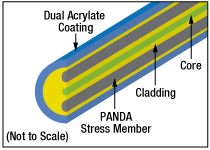
Click for Details
PANDA型PMファイバの断面図
- フォトダークニングを抑える純粋石英コア
- PANDA型のストレスロッド
- 動作波長範囲:350~680 nm
この純粋石英コア偏波保持ファイバは、350~680 nmの動作波長用に設計されています。この純粋石英コアによって、フォトダークニングを抑制し、短波長でのご使用が可能になります。このファイバは偏波保持動作用にPANDA型のストレスロッドを使用しています。
| Item # | Wavelength Range | MFDa | NAb | Core Index | Cladding Index | Cut-Off | Attenuation | Beat Length | Cladding Diameter | Coating Diameter | Strip Tool |
|---|---|---|---|---|---|---|---|---|---|---|---|
| PM-S350-HP | 350 - 460 nm | 2.3 µm @ 350 nm | 0.12 | Callc | Callc | ≤340 nm | - | 1.5 mm @ 350 nm | 125 ± 2 µm | 245 ± 15 µm | T06S13 |
| PM-405 | 400 - 488 nm | 3.5 ± 0.5 µm @ 410 nm | 0.09 | 365 ± 35 nm | ≤50.0 dB/km @ 410 nm | ≤1.7 mm @ 410 nm | |||||
| PM-S405-XP | 400 - 680 nm | 3.3 ± 0.5 µm @ 405 nm 4.6 ± 0.5 µm @ 630 nm | 0.12 | 380 ± 20 nm | ≤30.0 dB/km @ 488 nm ≤30.0 dB/km @ 630 nm | 2.0 mm @ 405 nm |


Click for Details
PANDA型PMファイバの断面図
- 動作波長範囲:460~2200 nm
- PANDA型のストレスロッド
この偏波保持ファイバは、可視、近赤外、および通信波長域でシングルモードで伝送するよう設計されています。偏波保持動作用にPANDA型のストレスロッドを使用しています。
| Item # | Wavelength Range | MFDa | NAb | Core Index | Cladding Index | Cut-Off | Attenuation | Beat Length | Cladding Diameter | Coating Diameter | Strip Tool |
|---|---|---|---|---|---|---|---|---|---|---|---|
| PM460-HP | 460 - 700 nm | 3.3 ± 0.5 µm @ 515 nm | 0.12 | Callc | Callc | 410 ± 40 nm | ≤100 dB/km @ 488 nm | 1.3 mm @ 460 nm | 125 ± 2 µm | 245 ± 15 µm | T06S13 |
| PM630-HP | 620 - 850 nm | 4.5 ± 0.5 µm @ 630 nm | 570 ± 50 nm | ≤15 dB/km @ 630 nm | 1.8 mm @ 630 nm | ||||||
| PM780-HP | 770 - 1100 nm | 5.3 ± 1.0 µm @ 850 nm | 710 ± 60 nm | ≤4 dB/km @ 850 nm | 2.4 mm @ 850 nm | ||||||
| PM980-XP | 970 - 1550 nm | 6.6 ± 0.5 µm @ 980 nm | 920 ± 50 nm | ≤2.5 dB/km @ 980 nm | ≤2.7 mm @ 980 nm | ||||||
| PM1300-XP | 1270 - 1625 nm | 9.3 ± 0.5 µm @ 1300 nm | 1210 ± 60 nm | ≤1.0 dB/km @ 1300 nm | ≤4.0 mm @ 1300 nm | ||||||
| PM1550-XP | 1440 - 1625 nm | 10.1 ± 0.4 µm @ 1550 nm | 0.125 | 1380 ± 60 nm | < 1.0 dB/km @ 1550 nm | ≤5.0 mm @ 1550 nm | |||||
| PM2000 | 1850 - 2200 nm | 8.0 µm @ 1950 nm | 0.20 | 1720 ± 80 nm | < 11.5 dB/km @ 1950 nm < 22.5 dB/km @ 2000 nm | 5.2 mm @ 1950 nm |


Click for Details
PANDA型偏波保持(PM)ファイバの断面図
用途
- グレーティング型励起半導体レーザ用のピグテール
- マルチプレクサ
特長
- 典型的な偏波保持(PM)ファイバの性能に感光性を付加
- PANDA型の応力付与
- 高い感光性
- ロット間の均一性が良好
980 nmの感光性偏波保持ファイバPS-PM980は、970~1550 nmのPMファイバのあらゆる性能を兼ね備えていますが、グレーティングを形成するために必要な高い感光性が付加されています。 このファイバにUV光を照射するとその部分の屈折率が変化し、ファイバーブラッググレーティングが形成されます。
このファイバは、980 nmの励起半導体や光カプラ、マルチプレクサとしての使用に適した設計になっています。 このファイバは、偏波保持特性だけでなく、感光性を同時に有するため、書き込み時間が短縮され、コスト削減につながります。
| Item # | Operating Wavelength | MFD | NA | Core Index | Cladding Index | Cut-Off Wavelength | Attenuation | Cladding Diameter | Coating Diameter | Strip Tool |
|---|---|---|---|---|---|---|---|---|---|---|
| PS-PM980 | 970 - 1550 nm | 6.6 ± 1.0 µm @ 980 nm | 0.12 | Calla | Calla | 900 ± 70 nm | ≤3.0 dB/km @ 980 nm | 125 ± 1.0 µm | 245 ± 15 µm | T06S13 |


Click for Details
PANDA型PMファイバの断面図
特長
- 分散:1550 nmにおいて-100 ± 10 ps/(nm•km)
- 分散スロープ:1550 nmにおいて-0.34 ps/(nm2•km)
- 標準的な1550 nm偏波保持ファイバに合わせた分散ならびに分散スロープ
- スロー軸の伝搬に最適化
用途
- パルス伸長、またはパルス圧縮ファイバ
- タイミング分配装置
- 通信
当社の偏波保持分散補償ファイバ(PMDCF)は、波長範囲1510~1620 nmにおいて標準的な偏波保持ファイバの色分散ならびに分散スロープの両方を補償します。サブピコ秒パルスが、直線偏光を維持しながら、低損失で、かつ色分散によるパルスの広がりなく伝搬します。 ファイバにはPANDA型のストレスロッドがファイバのコアに平行して付いており、応力を付与することでファイバーコア内に複屈折を生じさせ、偏波保持動作を可能にしています。特にスロー軸の光の伝搬用に設計されています。
| Item # | Operating Wavelength | MFD | NA | Core Index | Cladding Index | Cut-Off Wavelength, Slow-Axis | Attenuation | Cladding Diameter | Coating Diameter | Strip Tool |
|---|---|---|---|---|---|---|---|---|---|---|
| PMDCF | 1510 - 1620 nm | 5 µm @ 1550 nm | Proprietarya | Callb | Callb | 1400 nm | 0.40 dB/km (Typ.) @1550 nm 0.45 dB/km (Max) @1550 nm | 125 ± 1.5 µm | 250 ± 10 µm | T06S13 |

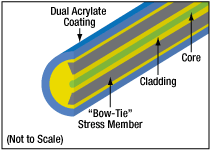
Click for Details
ボウタイ型PMファイバの断面図
- 動作波長範囲:980~1310 nm
- ボウタイ型のストレスロッド
この偏波保持ファイバは、ボウタイ型のストレスロッドを使用しています。一般に、EDFAレーザの偏波多重、レーザのピグテールに使用されます。
| Item # | Design Wavelengtha | MFDb | NA | Core Indexc | Cladding Indexc | Cut-Off | Attenuationd | Beat Lengthe | Cladding Diameter | Coating Diameter | Strip Tool |
|---|---|---|---|---|---|---|---|---|---|---|---|
| HB980T | 980 nm | 5.3 - 6.4 µm | 0.13 - 0.15 | 980 nm: 1.45647f | 980 nm: 1.45068f | 870 - 970 nm | ≤3 dB/km | ≤2 mm | 125 ± 1 µm | 245 ± 15 µm | T06S13 |
| HB1250T | 1310 nm | 8.1 - 9.9 µm | 0.11 - 0.13 | 1310 nm: 1.45094g | 1310 nm: 1.44680g | 1100 - 1290 nm | < 2 dB/km | < 2 mm | 125 ± 1 µm | 400 µm ± 5% | T06S16 |


Click for Details
ボウタイ型偏波保持(PM)ファイバの断面図
- 曲げおよび温度耐性が必要な用途向け
- 光ファイバージャイロスコープ(FOG)の用途に
- ボウタイ型
この偏波保持ファイバは光ファイバージャイロスコープ(FOG)の用途に適しています。 小さなコイル半径で幅広い温度領域にわたって、適切な性能を発揮できるように設計されています。 このファイバの消光比の典型値は、-40 °Cで29.5 dB、-60 °Cで28.5 dBとなっています。
| Item # | Design Wavelengtha | MFDb | NA | Core Indexc | Cladding Indexc | Cut-Off | Attenuationd | Beat Lengthe | Cladding Diameter | Coating Diameter | Strip Tool |
|---|---|---|---|---|---|---|---|---|---|---|---|
| HB800G | 830 nm | 3.7 - 4.9 µm | 0.14 - 0.18 | 830 nm: 1.45954f | 830 nm: 1.45282f | 660 - 800 nm | ≤5 dB/km | ≤1.5 mm | 80 ± 1 µm | 165 ± 10 µm | T04S10 |
 Products Home
Products Home












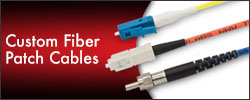

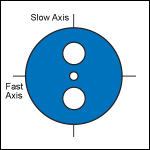
 ズーム
ズーム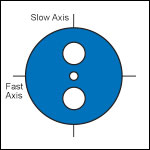
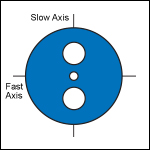
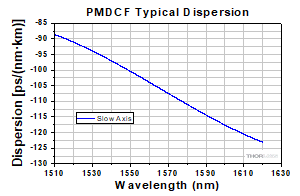


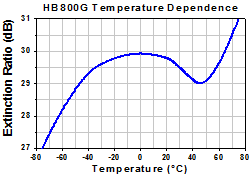
 シングルモード偏波保持ファイバ
シングルモード偏波保持ファイバ